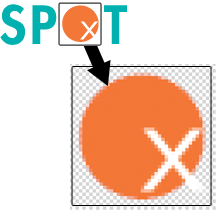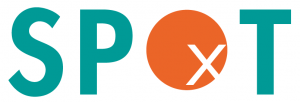You always want your logo to look stellar, both in print and online. After all, your logo is an instantly recognizable snapshot of your brand and your business!
Vector and raster are two terms you’ve probably heard before, and if you’re not a graphic designer, you might not be 100% clear on the difference between the two. As a small business owner, it’s important to have a general knowledge of these terms. Why? Because when it comes to your logo, you should be sure you receive the appropriate formats from your graphic designer so you have the flexibility to use your logo when and where you want to!
Raster Graphics: Pixel Perfect
A pixelated image is called a raster graphic. A pixelated file consists of a number of little grid squares filled with color. Together, these tiny squares (or pixels) of color create an image, such as your logo.
Raster graphics are resolution dependent. The higher the number of pixels per inch, the higher the resolution of the image. Websites are 72 pixels per inch (or PPI), whereas newspapers are around 200 PPI and magazines are at least 300 PPI. You may have also heard the term DPI, which means dots per inch. Not to worry – one dot per inch is the same as one pixel per inch. The term DPI is a measurement of print resolution, as opposed to PPI, which is used to describe screen resolution.
inch, the higher the resolution of the image. Websites are 72 pixels per inch (or PPI), whereas newspapers are around 200 PPI and magazines are at least 300 PPI. You may have also heard the term DPI, which means dots per inch. Not to worry – one dot per inch is the same as one pixel per inch. The term DPI is a measurement of print resolution, as opposed to PPI, which is used to describe screen resolution.
An image looks “pixelated” when the image is below the required PPI or DPI for optimal resolution.
Vector Graphics: Flexible Format
A vector graphic is composed of mathematically drawn lines, points and fills.  This means the same vector image can be scaled down to the size of the head of a pin, or blown up to billboard-size without losing resolution. Unlike raster graphics, vector graphics are not resolution dependent, so the image never looks pixelated,
This means the same vector image can be scaled down to the size of the head of a pin, or blown up to billboard-size without losing resolution. Unlike raster graphics, vector graphics are not resolution dependent, so the image never looks pixelated, regardless of size.
regardless of size.
For this reason, your logo should be designed in vector format.
However, vector graphics can be slightly limiting when it comes to level of detail. Now, this shouldn’t matter too much when it comes to your logo. A great logo should have a clean look so that’s it’s instantly recognizable to your target market.
Your Logo Arsenal – Raster + Vector Graphics
Your logo arsenal should contain both raster and vector graphic formats. When you work with a graphic designer to create your logo and your brand, you should always request the following:
- Native file(s). These are the original files used to create your logo. These should be in an .EPS format. Unlike raster files, you probably won’t be able to open these on your computer, but these files are what your designer and/or printer will request, mainly for print materials.
- Fonts. You should always know which fonts were used to create your logo, as they can be used for additional brand components.
- .JPG file(s). This is the universal raster version of your file(s), which can be used on your website or other online outlets. (Other raster file formats are .PNG, .GIF and .TIF.)
- Multiple color versions. For both the vector and the raster files, you’re going to want multiple color options in case you need them. This includes B&W (black and white), RGB (red, green, blue – used mainly online), CMYK (cyan, magenta, yellow and black – used mainly in print) and PMS (pantone mixing system for standard industry colors and exact color matching).
Having multiple versions of your logo allows you the flexibility to do what you want with your logo, when you want to! Sponsoring a charity event? Creating a new website? Need new signage? Now you’ll be ready when the designer or printer asks for your logo!
Share this post: Facebook It
